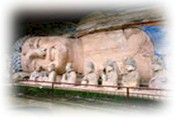| back  photo1 photo1
 photo2 photo2
 photo3 photo3
|
A city of
south-central China on the Yangtze River (Chang Jiang) and the youngest provice-leverl
municipality. It was the capital of China from 1937 to 1946. Population 2,080,000.  Grotto Art in Dazu County Grotto Art in Dazu County
There are more than 50,000 Buddhist Taoist and Confucian rock carvings and 100,000
characters of inscriptions dotted around Dazu. The carvings not only include the statues
of Buddha and Bodhisattva, but also include that of monarchs, ministers, military
officers, high and low-ranking officials, jailers, executioners, monks, rich and poor
people, and folk art performers. The earliest grotto was caved in the early Tang dynasty,
and most of them have a history over 1000 years.
Eling Park
built in 1909, which was originally the home of Lee, a rich businessman, also known as
"courteous park", with special plant species and a newly built tower (Liangjiang
Pavilion) providing the view of the entire city. In 1958, large-scale of restoration was
carried out on the site of Lee Garden and the park was "Eling Park".
People's Assembly Hall
As architectural symbol of Chongqing, the hall was built in 1951 and designed in the
traditional symmetrical and beautifully-proportioned style of Ming and Qing dynasties'
palaces, containing a 4000-seat auditorium.
Ocean Park
A blue 'Ocean' will rise in this city with a large population and embraced mountains,
which is Chongqing Ocean Park, invested by Hong Kong Yee Fung Holdings Development Co.
(back) |